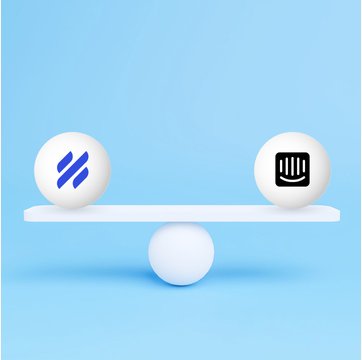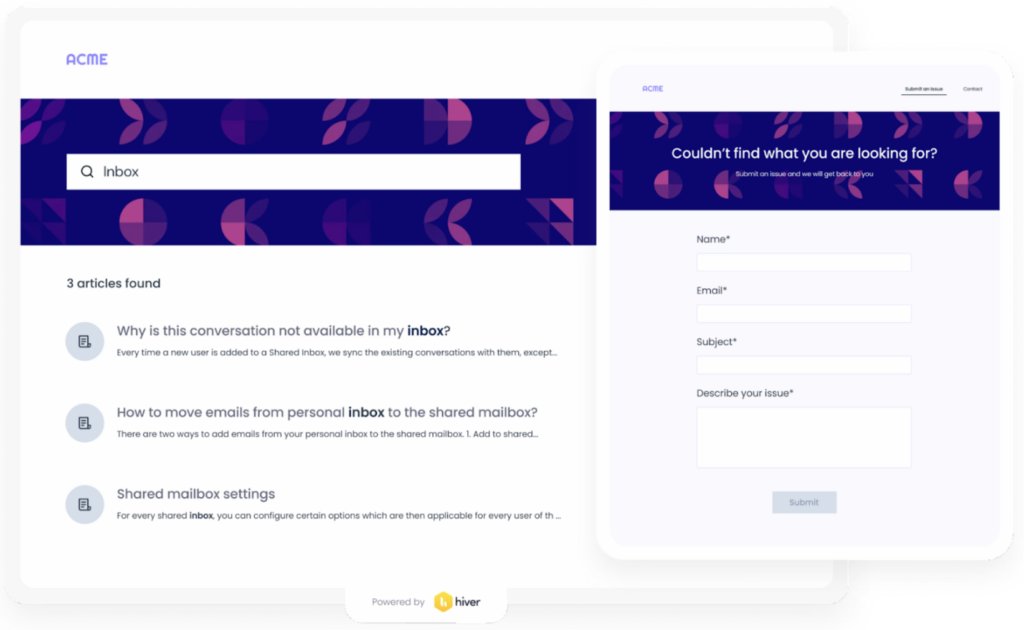Help Scout vs Intercom: A Comprehensive Comparison

Table of contents
When it comes to managing support queries and assisting customers, picking the right tool is important. Two big names that can help with this are Help Scout and Intercom.
Help Scout is popular for making customer support simple and more human-like. Intercom is known for its chat and messaging features, which assist in real-time customer communication.
But which of the two is more relevant for your business?
In this blog, we compare Help Scout vs Intercom – see what features and pricing they offer. This way, you can make an informed choice on which customer support platform to use.
Table of Contents
- What is Help Scout?
- What is Intercom?
- Help Scout vs Intercom: A Quick Comparison
- Which tool should you choose?
What is Help Scout?
Help Scout is a customer service platform that helps you manage all your customer conversations in one place. It works like an inbox, making it easy to keep track of customer chats, emails, and messages. With Help Scout, you can centralize all different types of customer conversations into one platform.
10 Best Help Scout Alternatives
What is Intercom?
Intercom is a customer service platform that is designed to streamline communication between businesses and their customers. This platform is noted for its real-time messaging capabilities and Engagement OS which enables effective ticket management. Intercom helps customer support teams gather, track, and collaborate on queries from a single unified platform.
Help Scout vs Intercom: A Quick Comparison
| Comparison Points | Help Scout | Intercom |
|---|---|---|
| Value for money | Straightforward pricing. Starts at $25 per user per month. | Complicated pricing structure and is expensive. Starts at $39 per user per month. |
| Ease-of-use | The interface can be confusing. Merging multiple tickets is not possible. | Clean interface with advanced ticketing and automation features. |
| Messaging | Offers a messaging feature, named Beacon. But not as powerful as that of Intercom. | Intercom’s Messenger feature is more powerful and includes advanced AI functionalities. |
| Reporting | Offers seven different types of reports. | Offers lesser report types than Help Scout. |
| Customer Data | Basic customization options for managing customer data and profiles. | Extensive customization options for managing customer data, based on different criteria. |
| Knowledge Base | Offers a straightforward and user-friendly knowledge base called Docs. But it’s not as comprehensive as Intercom. | Provides a dynamic knowledge base. Features include Messenger and rich content editing, amongst others. |
| Free Trial | 15 days | 14 days |
1. Value for money: Help Scout is less expensive than Intercom.
Let’s compare what each platform offers, as per their pricing packages.
Help Scout Pricing:
- Standard: Costs $25 per user per month ($20 if billed annually). It includes 2 shared inboxes (supporting email, live chat, Instagram, and Facebook Messenger),integration with over 100 integrations, and more.
- Plus: Priced at $50 per user per month ($40 if billed annually). This plan builds on the Standard features by offering 5 shared inboxes, advanced tracking, and more.
- Pro: Available for $65 per user per month, but only on an annual basis. It includes everything in the Plus plan, with 25 shared inboxes.
Intercom Pricing:
- Essential: Costs $39 per seat per month. It includes features like a shared inbox, basic automation, and a ticketing system.
- Advanced: Priced at $99 per seat per month. Includes features of Essential plan, along with multiple team inboxes, multilingual help center, Fin AI Summarize, and workflows.
- Expert: Costs $139 per seat per month, suitable for large support teams with advanced collaboration, security, and reporting tools.
- Proactive Support Plus Add-On: Available from $499 per month, including 3,000 messages sent monthly. This add-on provides product tours, checklists, surveys, and more.
In Intercom, as you add more team members and extra features, the cost goes up. For instance, Fin, AI Bot, is free for the first 14 days but then costs $0.99 per resolution it handles. Additionally, Intercom does offer a 95% discount for early-stage startups, but this plan has strict eligibility requirements.
Comparing the two tools, it’s evident that Help Scout is priced lower than Intercom. Help Scout’s flexible pricing and tiered features make it a potentially more cost-effective choice for a range of businesses.
At the same time, if you’re looking for a customer support tool that offers the best value for money, then try Hiver. Plans start at $19/month per user. There’s also a free forever plan available, with email management and collaboration features.
2. Interface and Ease-of-use: Intercom offers a far more feature-rich interface.
Though Help Scout seems to have a simpler, more straightforward approach to customer support, Intercom offers more depth and complexity in its features.
Let’s see how these two tools differ.
Help Scout is often preferred by those seeking a tool that offers a more personal touch in customer interactions. The platform comes with a clean and functional interface.
However, it falls short in some areas. Users have reported frustration with its limited search functionality and the inability to merge multiple tickets.
Also, the design of the platform is such that users might mix up internal and external conversations. So, there’s a chance that an agent might accidentally send a message that was meant for a coworker to a customer.
“Help Scout does not have a modern design. Also, whenever I reply to an email, Help Scout will duplicate that email in my inbox, instead of joining the two emails together.” – Help Scout User Review | G2
Intercom, on the other hand, is recognized for its powerful and adaptable interface. It offers a wide range of features and is highly customizable.
Its user-friendly nature is complemented by advanced features like automation, real-time support, and an extensive knowledge base.
More than Help Scout and Intercom, Hiver’s interface is unmatched. It works inside Gmail and Outlook, providing an easy-to-use and intuitive platform to handle customer support interactions.
Teams can manage multiple communication channels – email, live chat, phone, and knowledge base – right from the comfort of their inbox. The best part here is that you can get started right away with Hiver, without any extensive training.
3. Messaging: Intercom has a more powerful business messaging feature.
While Help Scout excels in handling customer emails, Intercom is popular for its ‘Messenger’ feature.
Intercom’s Messenger goes beyond a simple chat widget. It offers:
- Customizable Design: Intercom’s Messenger offers high customization, allowing you to customize the interface based on your specific brand colour and guidelines.
- Smart Article Suggestions: Incorporates machine learning to offer more relevant support articles to customers.
- Efficient Ticket Handling: The Messenger-first tickets feature enables real-time support, making query resolution faster. This is integrated within Intercom’s Inbox for complete support management.
Additionally, Intercom places a strong emphasis on using chatbots for managing customer interactions.
For instance, Intercom’s task bots can gather important details about a customer’s issue or recommend a useful article. Resolution bots are designed to automatically respond to frequently asked questions.
Help Scout also has a messaging feature, known as Beacon.
Beacon is a messaging tool that helps customers get help quickly and easily. Customers can choose how they want to interact with the company – through chat or email, or by reading help articles instantly.
While Help Scout provides a messaging feature, it doesn’t quite match the robustness of Intercom’s Messenger.
Intercom’s messenger feature stands out for its extensive customization options, integration of AI, and a wider range of support functionalities.
4. Reporting: Help Scout offers more report types than Intercom.
Both Help Scout and Intercom offer unique reporting features.
But Help Scout provides a variety of predefined reports with real-time updates.
Help Scout offers seven different reports, including All Channels, Email, Chat, Phone, Company and User, Happiness, and Docs reports.
- The All Channels report offers insights into customer contact volume, busy periods, contact methods, and recurring issues.
- Email report tracks team interactions with customer emails.
- Chat report analyzes team workload and customer usage of Beacon chat.
- Phone report details the volume of phone conversations.
- Company and User reports provide insights into team member performance.
- Happiness report measures customer satisfaction based on ratings and feedback.
- Docs report helps in understanding customer search behaviors and knowledge base utilization.
On the other hand, Intercom allows you to create custom reports to get the data you need in the format you prefer. But it is not as comprehensive as Help Scout.
“There are so many limitations in Intercom on what cannot be exported into reports and what nothing. The biggest issue with it is its inability to generate sufficient and adequate reports. You spend a chunk of your time creating reports out of the data from the intercom.” – Intercom User Review | G2
Some other report types of Intercom include:
- Prebuilt Reports: These include the Overview report, which gives a high-level overview of new users, conversations, team performance, and self-service support.
- Conversation Insights: The Conversations report offers insights into the team’s workload, customer issues, and inbox status, with dynamic filters for detailed analysis.
- Customer Satisfaction: This report provides details on conversation ratings and remarks from customers, with advanced filtering for specific topics or conversation types.
When comparing the two tools, Help Scout’s reporting features stand out as more robust. This makes Help Scout’s reporting more suitable for businesses seeking comprehensive, data-driven insights into customer interactions and support performance.
While Help Scout and Intercom offer specialized analytics dashboards, Hiver sets itself apart by integrating its Analytics feature within Gmail. This means users can create and access reports in Gmail itself – without having to switch between various applications.
5. Customer Data: Extensive customer data management and customization is available in Intercom.
Both platforms automate customer profile creation but have different approaches.
Help Scout helps create customer profiles from email conversations, while Intercom centralizes data across various channels to build customer profiles.
Help Scout automatically creates a customer profile when a customer emails the support address for the first time. Profiles can also be created manually when composing a new conversation.
On the other hand, Intercom offers a complete picture of every customer, including business type, location, spending, and more. The tool allows prioritization and routing of customer conversations based on attributes like topic or urgency.
Users can track custom data unique to their business, such as pricing plans or product types. Besides, the platform provides the functionality to route VIP customers or urgent issues to the top of the support queue, ensuring high-value customers are attended to promptly.
In summary, Help Scout’s customer data feature focuses on individual customer profiles and basic customization. Whereas, Intercom offers a more integrated approach, with the ability to engage with customer segments based on a wide range of criteria.
6. Knowledge Base: Help Scout’s knowledge base is not as advanced as Intercom’s.
The knowledge base feature of Help Scout and Intercom is designed to empower customers with self-service options through comprehensive support documentation.
Here’s a detailed comparison of their respective knowledge base features.
Help Scout’s knowledge base feature, also known as Docs, allows customers to find answers to frequently asked questions or information about the company. There’s no limit to the number of articles you can add in Docs.
Help Scout’s knowledge base is strictly for self-help.
On the other hand, Intercom provides a more comprehensive knowledge base feature, offering 24/7 support. The knowledge base created through Intercom can be optimized for various channels like websites, mobile apps, in-product messages, or chat.
Each article includes a Messenger option, allowing customers to start a conversation for further assistance. Additionally, there’s flexibility to create help content for different audiences, such as paid users or visitors, and even language-specific content.
So, while both platforms allow unlimited article creation, Help Scout has a file size limit for uploads (10 MB file size limit for individual uploads).
Hiver’s Knowledge Base integrates seamlessly with Gmail. It offers easy article creation and custom domain setup. Articles can be organized into categories and tagged for easy navigation and retrieval. Administrators can set permissions to control who can view or edit articles, ensuring security and relevance.

Which tool should you choose?
When deciding on a customer support tool, it’s important to consider what fits best for your business. Help Scout is a good choice for small to medium-sized businesses. It’s easy to use and can grow with your business, especially if you’re focusing on customer support and managing emails.
For larger companies that need a tool for more than just customer support, like running marketing campaigns or managing leads, Intercom is a better fit.
But if you’re looking for a customer support platform that is easy to use, offers good value for money, and doesn’t require extensive training, Hiver is a great option. Get started with Hiver today. Free for 7 days.

































